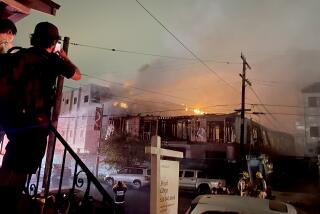The Ghost Ship fire was ‘a matter of benign neglect.’ It’s not the only one

The Ghost Ship fire tragedy puts a focus on the plight of Oakland artists dealing with soaring Bay Area housing costs. (Francine Orr / Los Angeles Times)
Reporting from OAKLAND — This city has long been known as the industrial and trading hub of the Bay Area, dotted with shipping depots, armories as well as many old warehouses and shuttered manufacturing facilities.
And it’s no secret that as rents skyrocketed, some of those warehouses were illegally converted into housing that lacked the fire systems, earthquake strengthening and other safety measures required by law.
A review of public inspection records, city emails and interviews shows that the city of Oakland for more than a decade often failed to conduct safety inspections on illegally converted warehouses, even those that were well known.
Without the inspections, the city could not require owners to bring the building up to code or force the residents out.
The records show a pattern of city inspectors frequently citing building owners for blight violations — graffiti on walls and fences, tall weeds or piles of trash. They returned often to ensure those exterior nuisances were corrected and, if not, levied liens against owners to collect inspection fees. Investigations opened because of complaints of illegal habitation were routinely closed without action by inspectors who said they did not gain physical entry inside the buildings, the documents and interviews show.
This pattern is now under intense scrutiny in the wake of the Ghost Ship fire, in which 36 people died in an illegally converted warehouse earlier this month.
“It was a matter of benign neglect — not made explicit because it couldn’t be,” said Thomas Dolan, a prominent architect of live/work spaces in Oakland, coauthor of the city’s 1996 building code encouraging such conversions, and a member of a housing task force that advised Mayor Libby Schaaf.
“This is a part of life in Oakland, and in many ways good for everybody, as long as something like the Ghost Ship doesn’t happen.”
A spokeswoman for the city said the assertion that Oakland tolerates illegal warehouse conversions is “untrue in concept.”
Oakland “can never turn a blind eye” to safety, “nor can we approach this work with anything but compassion.”
“We know it’s a tall order, but we want residents and property owners to work with us to find solutions that protect lives and support the diverse array of communities that make Oakland Oakland,” Erica Derryck, the communications director for Schaaf, said Friday.
On paper, the Ghost Ship was zoned for commercial use.
In reality, the Ghost Ship operated off the radar as a rogue art collective and venue for underground music performances, and home for some dozen itinerant tenants. There is no official count, but city officials privately estimate Oakland has some 50 such illegal communities existing in various states of repair and safety.
No cause for the Ghost Ship fire has been released, but former tenants and firefighters described do-it-yourself wiring and an internal maze of structures and junk and haphazard wood stairs that invited fire and would have made escape difficult.
The city Fire Department, charged with checking commercial buildings every two years, has yet to release inspection records. City planning department records show the commercial warehouse was visited by code inspectors repeatedly for blight conditions.
Twice there were reports of illegal occupancy, but not once in 30 years did code inspectors set foot inside, documents show. An investigation of reported illegal interior structures two weeks before the fire was left “pending” after an inspector said he was unable to gain entry to verify the complaint.
The Ghost Ship is far from unique, records show.
One illegally converted warehouse, which doubled as a public space with its own Facebook events page, was visited 17 times in 2011 by city code inspectors, records show.
They checked brickwork, weeds and paint. The building was never cited for illegal occupancy, even after an inspector noted an improper gas vent coming out of an opening and a city clerk reported the building owner admitted he had people living in the building, for which the city had no record of permits.
Citations requiring compliance with modern safety codes at two other converted industrial buildings came only after a March 2015 fire killed two men, Davis Letona, 27, and Daniel Thomas, 36, and damaged both buildings.
The men, both artists, lived in a former National Guard armory that was carved up into apartments. A city report said the three-alarm West Oakland fire apparently was started accidentally by one of the victims smoking in bed.
The building next to it, home to some 30 tenants, also housed an anarchist press that had just published a tome on the San Francisco Bay Area housing crisis. It has now been sold to a prominent warehouse loft developer.
Occupants said only one of the adjacent buildings had a fire alarm to alert residents to escape.
In an internal city email, an Oakland housing official noted that both buildings had long been illegally occupied.
Another warehouse with more than 150 residents was occupied illegally for more than a dozen years.
Inspectors who went inside the former Greyhound bus depot after a tenant began a YouTube campaign to shame his landlord found that units lacked heat, the walls were a maze of illegal wiring, open stairs and balconies created fall hazards, and the building lacked emergency exits.
Tenants over time had erected interior walls, stairs and even new levels. Inspectors said one tenant had built interior lofts four stories high with 30 to 40 subtenants.
“Now that the city is aware of the situation, we are responsible for the safety of the occupants,” then-Oakland planning chief Rachel Flynn wrote in an early November 2015 email warning the city administrator that her agency was now forced to close down the building.
“Such an evacuation will no doubt upset the owner, the tenants, and perhaps others.”
Flynn, who now works for an area developer, did not return calls. Although city officials called the Market Street warehouse “unsafe to occupy” and its residents “in harm’s way,” the building remained occupied three more months before the city enforced evictions.
There is general agreement that Oakland, in the process of rapid gentrification, is caught between too many abandoned warehouses and too many low- and middle-income newcomers seeking a place to live.
The buildings are a legacy of the city’s industrial past as a wartime shipping port. The conversion of ammunition depots and paint factories into unorthodox living spaces took hold in the early 1990s as the city rebuilt from the Loma Prieta earthquake. It flourished under leaders such as then-mayor, now Gov. Jerry Brown, who bought a loft in a waterfront Oakland warehouse in 1994.
Developers, owners and tenants said the cost of living in an unpermitted warehouse is usually less than $1 per square foot, about a third of what the legalized market charges.
The cost of bringing those 1920s brick buildings up to modern code is enough to persuade owners to stay off the radar, said developer John Protopappas, who oversaw the finances of Schaaf’s 2014 election campaign and whose company handled rent collections for the illegal Market Street warehouse.
“To legalize use is very hard and difficult. They say, forget it. I’m not going to do it,” Protopappas said.
His company recently finished installing sprinklers at another warehouse conversion complex it manages called Vulcan Lofts. Protopappas said the upgrades were voluntary and not forced by the city.
When community news publisher Yeon Lee purchased the Magnolia Street warehouse in 2003, there were more than a dozen tenants already living there. Without his knowledge, Lee said, his renters added a stage for community events that ranged from belly dancing exhibitions to classical music. A former resident said tenants dubbed the building “Death Trap” after a city inspector used that phrase to describe their home.
People were already living in the warehouse when Lee bought it. Their occupancy was an open secret, as obvious as the household trash containers and lawn chairs parked outside the door. Lee said he considered trying to legally convert the building to residential use after he bought it but found the cost prohibitive.
“We knew they lived there,” Lee said. “The city knew too. The city didn’t say anything about it, and there are so many warehouses like that.”
The Ghost Ship fire changed that.
Lee said he has decided to evict his tenants and Oakland has decided to cite him for illegal occupancy.
Dolan said he broached the topic of safety in Oakland’s uninspected “extra-legal” warehouses while on a housing task force in 2015. He suggested Oakland offer informal, “no tell” inspections to warn tenants and building owners of the most serious dangers, and offer amnesty to owners of illegally converted buildings who came forward.
“I may have described it as the elephant in the room,” he said. “They said there was no way they could, because if they knew, then they had to act.”
After the Ghost Ship fire, Dolan and other volunteers took it on themselves to offer those same off-the-record safety checks, giving landlords a chance to correct fire hazards even if without city permits and approval.
Oakland inspectors are also on the prowl.
Days after the fire they returned to previously bypassed warehouses, acting on new complaints filed by the city Fire Department and neighbors. At least two have been cited for illegal occupancy even though inspectors still said they were unable to gain entry.
At one warehouse, an inspector based the violation on the number of mailboxes affixed to an outer wall next to a single door.
A year earlier the department fielded multiple reports of people living at the same address. That investigation remained “pending” because the inspector could see nothing from the front and a neighbor said “he has not seen anything.”
Twitter: @paigestjohn
ALSO
Lawyers for Ghost Ship manager say they fear he will be charged to hide government negligence
For Ghost Ship rescuers, a scene they can never forget
After Ghost Ship and a crackdown, L.A.’s DIY music scene plans its response
More to Read
Sign up for Essential California
The most important California stories and recommendations in your inbox every morning.
You may occasionally receive promotional content from the Los Angeles Times.











